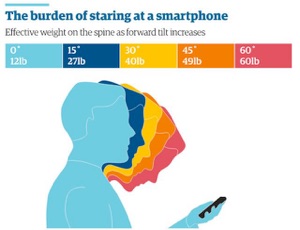Ergonomics:
*These ergonomic practices have helped me immensely. Check with your health care provider to see if these would be beneficial for your body.

-
• Neutral body posture: We don’t want to force our bodies into positions that are uncomfortable or difficult to maintain. Working from where they live, I encourage clients to find new ranges of motion closer to a neutral posture. (The graphic is only a reference but not to rigidly maintain 24/7.)
-
• Sleeping: 1/3rd of our life is spent sleeping! Here’s ways to support your body during rest so that you wake up rested, refreshed and relaxed.

oSide sleeping: If back sleeping doesn’t work due to back pain or snoring, side-sleeping can be just as rejuvenative if done correctly.

2) Try getting your lower shoulder underneath you and your upper arm resting along the side of your body. Hugging a pillow for a few weeks can help your body transition to this position. This minimizes the inward crushing of the chest wall. However, when the lower shoulder is further underneath your body, your neck will need to be elevated (larger pillow) to maintain a neutral spine.
3) Legs can be slightly bent with a small pillow in-between the knees. This keeps the hips stacked and prevents a torque in the pelvis.
oStomach sleeping: Relaxing on your stomach is okay but sleeping in this position for long periods creates a significant amount of torque and compression on your cervical spine.
-
• Sitting: It’s the worst. Transition to mostly standing if you have to be at a desk all day. Veridesk has very affordable sit-stand solutions. Regardless of position, try to walk or move around every 45 minutes.

2) Shoulders: Practice external rotation to keep them from rolling inward.
3) Arms: Elbow at 90 degrees, keep arms close to the body. Do not extend for repetitive movements.
4) Wrists: Keep neutral and inline with arm while typing or mousing. Wrist rests are invaluable but better yet is a Workrite Banana Board.
5) Spine: Ribcage neutral, low-back braced by your core.
6) Pelvis: Sitting on sitz bones, maintain a neutral position.
7) Thighs: Horizontal

-
• Phone Use: We don’t like to admit it, but phone use takes up more of our lives than we’d like. Try to keep your neck in a neutral position with arms externally rotated and a neutral wrist.
The Foot: The foundation of our balance and movement. Even if your issue doesn’t stem from your feet, proper mechanics can help get you out of pain.
Maintenance:
*These are tools that I use to maintain my physical health. Check with your health care provider to make sure they are appropriate for your condition.

I empower clients to continue the work at home. I work on myself / move daily and you can too.
-
• Ball Work:
oTennis Balls: A good intermediary as your tissues get used to deep work.

oLacrosse Balls: The best for deep tissue work but can be a little intense for beginners. They can be found at any sports equipment store for $4-$5/ea. Can also be found on Amazon for twice as much.
oSuperNova: A larger ball to get into hamstrings, pecs or shoulders.
•Foam Roller: Start soft and work your way up.
-
• Gemini: The best tool to target the spine.
-
• The Twin Block Pro is my go-to for neck work. The rest of the Massage Blocks product line is helpful as well.
-
• The Stick: Great for the legs, especially if you travel.
•Voodoo Flossing: One of my favorites for stiff and recovering joints. Rouge Fitness has a few options but start here first.
-
• Arm Aid: God’s gift to our upper limbs
-
• Balance Board: A lovely tool to improve stability and balance
•Yoga Ball / Stability Ball: Important for stability and core work. You probably have one in the garage that you never use.
Maintenance Books:
•What The Foot? - Gary Ward
•Becoming a Supple Leopard - Kelly Starrett
•The Roll Model – Jill Miller









